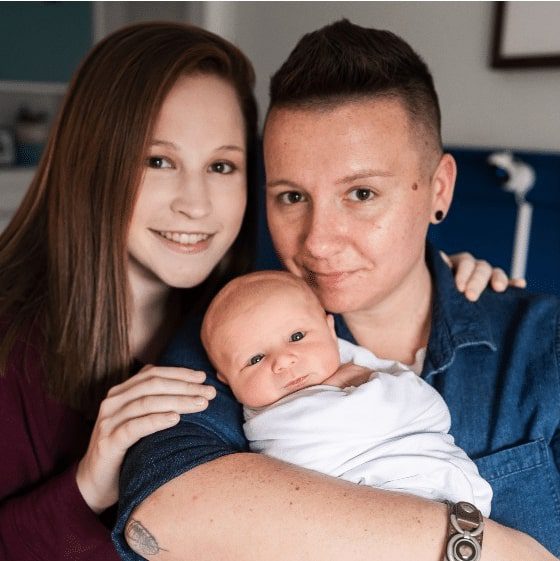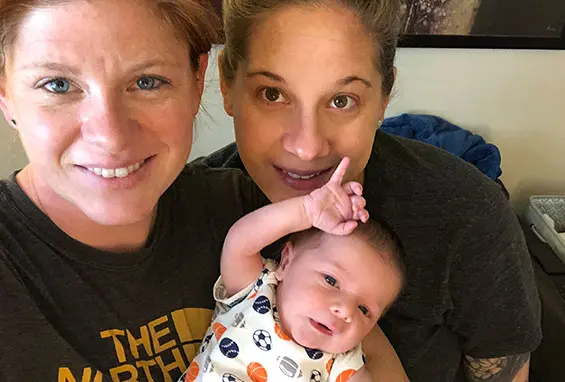LGBTQIA+ family building options
Dedicated to helping lesbian, gay, bisexual, transgender, queer, questioning, intersex, and asexual+ people realize their dream of parenthood, SGF offers a full range of services — from low-tech to highly advanced — to help you achieve successful outcomes.
Fertility options for gay men
Couples with two sperm providers and sperm-producing individuals planning to build a family through fertility treatments, you will meet with your physician to discuss the details of using an egg donor and gestational carrier.
Dual insemination
At SGF, two sperm providers can opt to use dual insemination wherein each partner provides sperm that can be used to create an embryo for transfer to a known or recruited gestational carrier to carry the pregnancy. In line with ASRM guidelines, only one embryo will be transferred, and any remaining embryos can be cryopreserved for later use.
The partner(s) wishing to use his sperm will undergo a semen analysis to test motility (movement), volume, concentration, and morphology (shape) of the sperm.
Selecting a gestational carrier agencies & attorneys
Finding a gestational carrier is often one of the first steps for patients. Our medical team will refer you to experienced and reputable attorneys and agencies to find a gestational carriers, a woman with no genetic tie with the child she is carrying. The average wait to be matched with a gestational carrier is around one year. All gestational carriers and intended fathers must seek legal counsel, even when working with a friend or family member.
Legal contracts as well as all medical and psychological screening for the gestational carrier must be completed prior to selecting an egg donor.
Selecting an egg donor
At SGF, our goal is to make the donor selection process as smooth as possible for our patients. All of our donors have been through rigorous screening before they appear in our donor database. For a variety of reasons, patients may opt to select a non-identified egg donor from Luminary Donor Eggs, other national egg banks, egg donor agencies, or directed (known) egg donor.
Fertility options for lesbian women
If you are a couple with two egg-producing individuals, when you begin your fertility journey, one of the first decisions you must make is who will carry the pregnancy. The partner carrying the pregnancy will then proceed with a fertility work-up. If there is a good prognosis, the next step is to select a sperm donor.
Selecting a sperm donor
SGF has partnered with Fairfax Cryobank, one of the largest and most trusted sperm banks. Fairfax Cryobank offers a wide selection of donors with childhood and adult photos, audio recordings, and essays written by the donors. View a list of the sperm banks we work with here.
If you may opt to use a known sperm donor such as a relative or friend, your care team will coordinate this process for you and your donor.
After you select the donor, the cryobank sends the frozen sperm sample directly to SGF. From there, you will undergo an intrauterine insemination or in vitro fertilization cycle using the donated sperm.
Co-IVF
Couples with two-egg producing individuals have the opportunity to share in the pregnancy through co-IVF, also known as reciprocal IVF. With co-IVF, one partner provides the egg and the other partner will carry the pregnancy. This is a more complex treatment protocol where both partners complete fertility testing and both will take medication to boost their fertility. Many couples enjoy this option which allows both partners to feel more connected to the pregnancy and the child.
Fertility options transgender and gender diverse couples or individuals
Transgender and gender diverse couples and individuals have a variety of options for fertility care depending on their unique situation. The most common options include fertility preservation, IUI, IVF, donor egg, donor sperm, donor embryo, and working with a gestational carrier. For transgender patients, hormonal transitions from birth sex to identified gender can impact fertility potential. For those patients who wish to have biological children, there are options for family building including fertility preservation.
Fertility preservation
To protect future family building options, individuals should consider freezing eggs, sperm or embryo. This should ideally occur prior to hormone therapy or surgery.
Trying to conceive
There are many ways for transgender individuals to be included in the family building journey with their partner.
Transgender men (FTM) with an egg producing partner
Transgender men and their partner can conceive using donor sperm. Treatment options will vary based on individual fertility testing but most patients are likely to conceive with intrauterine insemination (IUI) or in vitro fertilization (IVF).
Co-IVF is also an option for transgender men and their partner. With co-IVF, one partner provides the egg and the other partner will carry the pregnancy.
Transgender men (FTM) with a male partner
Transgender men with a sperm producing partner can work our medical team to review and temporarily postpone hormone therapy, allowing the couple to conceive with intercourse. If fertility treatments are needed, they may be eligible for intrauterine insemination (IUI) or IVF with or without a gestational carrier.
Transgender women (MTF) with a female partner
Transgender women with an egg producing partner most often opt to use intrauterine insemination (IUI) to conceive. If sperm was frozen prior to hormone therapies or surgery, that frozen sperm can be used. Otherwise, hormone therapy can temporarily cease for spermatogenesis to resume in order to obtain sperm. Alternatively, donor sperm can be used.
Transgender women (MTF) with a male partner
Transgender women with a sperm producing partner will need donor egg treatment using a gestational carrier. If sperm was frozen prior to hormone therapies or surgery, either the frozen sperm or the partner’s sperm may be used.
Learn more
Patient stories
Patient Story
Chad & Michael
Patient Story
Elle & Marquitta
Patient Story
Casey & Rachel
Patient Story






